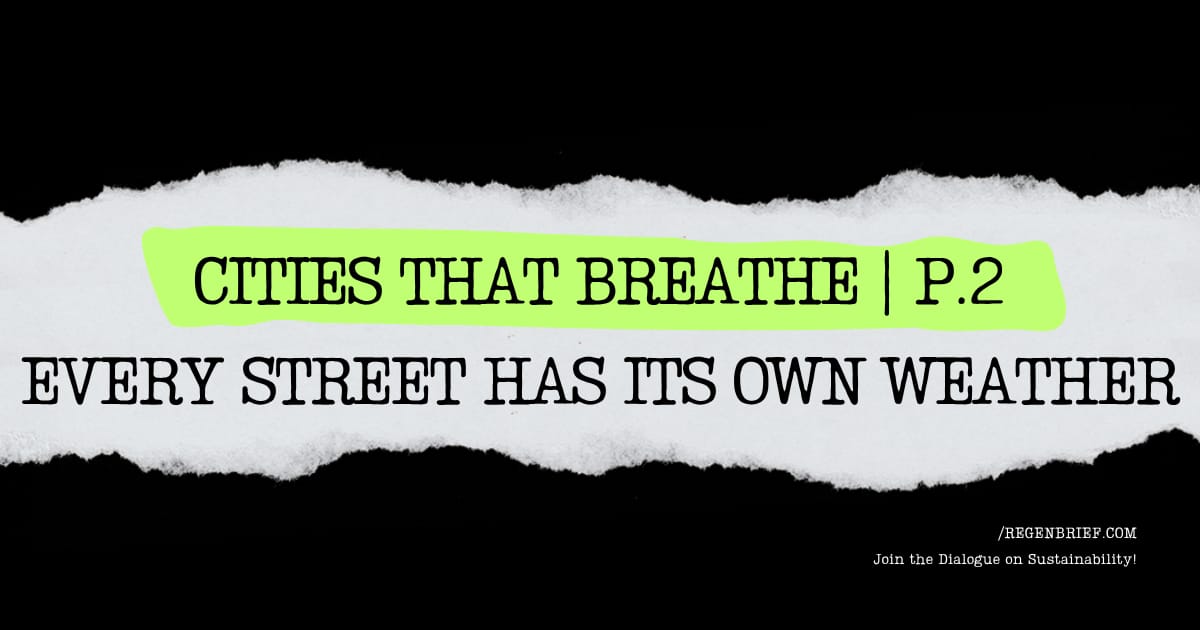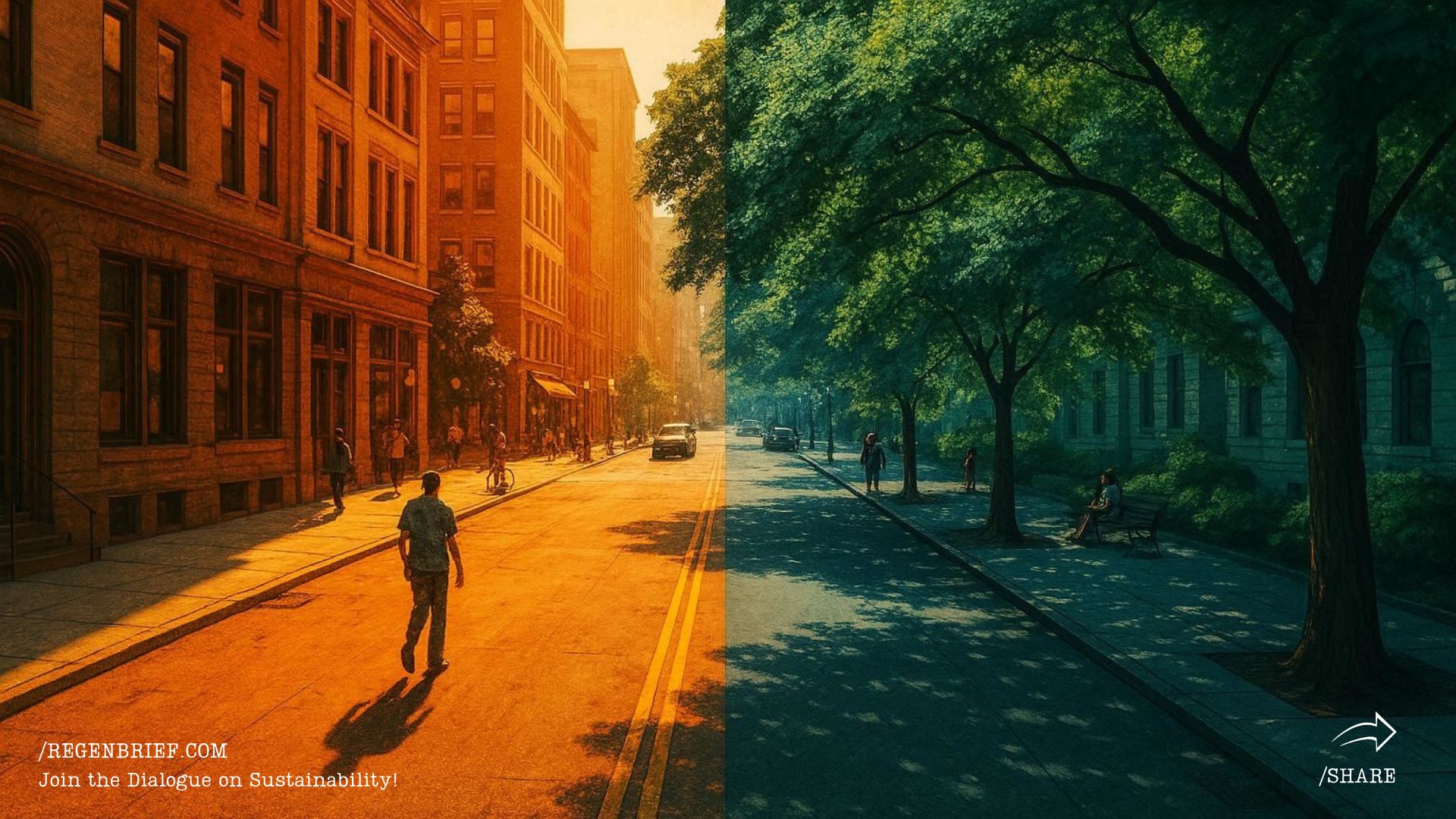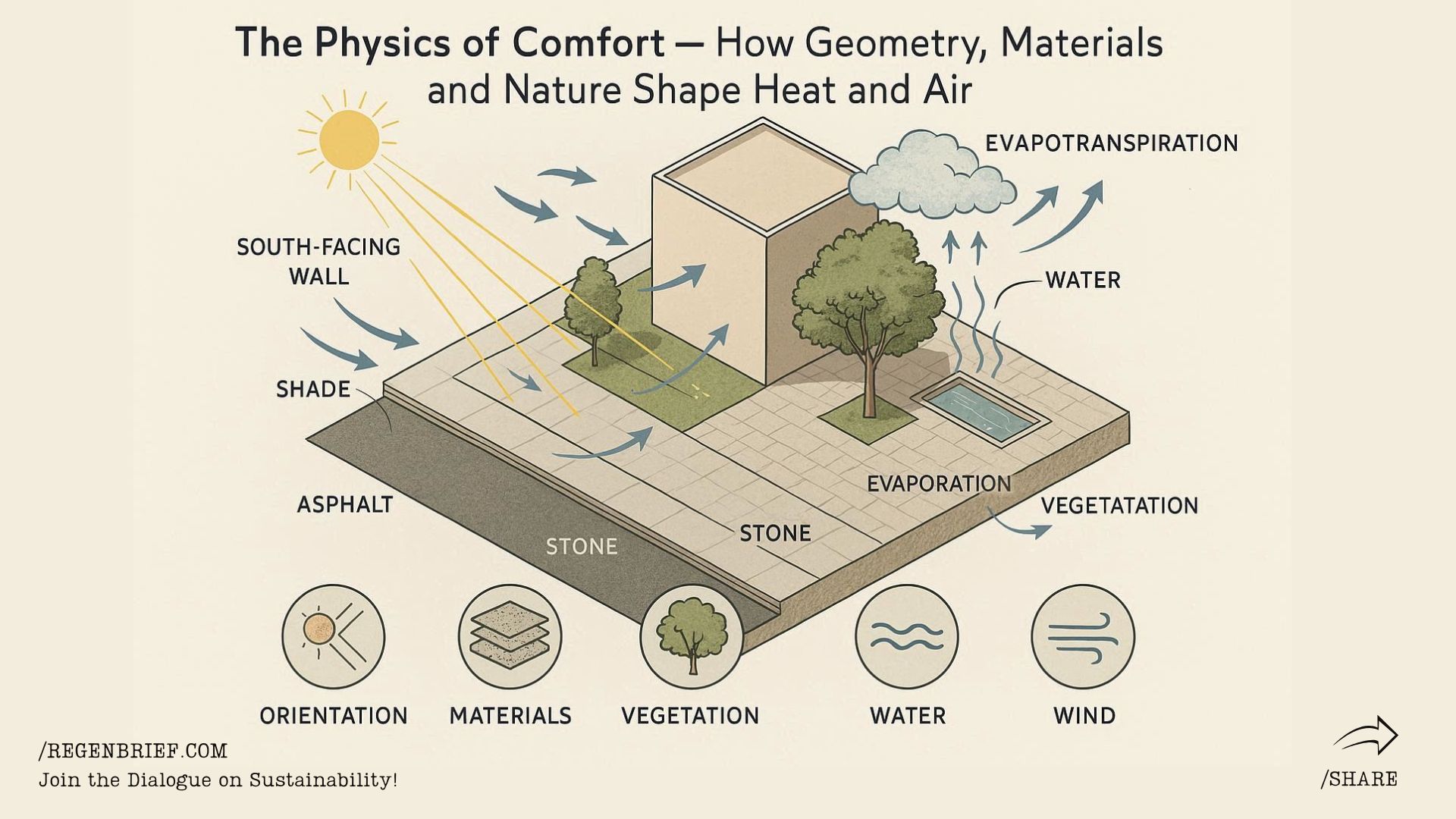- The Regenerative Brief
- Posts
- Cities That Breathe | Part 2 – Every Street Has Its Own Weather
Cities That Breathe | Part 2 – Every Street Has Its Own Weather
A single mature tree can cool the air as much as five air conditioners running for 20 hours.

Read Time: 5 minutes | Every Street Has Its Own Weather
The best way to predict the future is to design it.
Dear RegenBrief reader,
Walk through any city block and you will notice how temperature shifts every few meters.
One side of the street feels like an oven while the shaded side feels bearable.
A park breathes cool air that disappears at the next intersection.
These slight variations are called microclimates. They exist in courtyards, under bridges, around lakes, and even on rooftops.
They prove that there is no single “city temperature.”
Every corner has its own weather, shaped by the way buildings, materials, and nature interact.
The Mechanism | How Microclimates Form
A microclimate appears when local factors bend the larger climate.
Five main forces create them:
Orientation and geometry. South-facing walls in the Northern Hemisphere receive more sunlight. Narrow streets trap heat while wide streets allow breezes.
Material choices. Asphalt, brick, and metal surfaces store heat, while grass, water, and light stone stay cooler.
Vegetation. Trees release moisture and shade surfaces, cooling the air by several degrees.
Water. Even shallow ponds reduce local temperature through evaporation.
Wind. Building shapes can accelerate or block wind, forming pockets of still or moving air.
Every project decision, from façade color to tree spacing, can strengthen or weaken these forces.

People do not experience average temperature.
We live our days inside microclimates such as bus stops, courtyards, glass towers, and shaded plazas.
A city’s comfort and livability depend on how these microclimates feel.
Poorly designed streets can become heat traps that raise energy bills and push pedestrians indoors.
Well-designed ones invite walking, social life, and fresh air.
In dense regions like the Gulf, fine-tuning microclimates is one of the fastest ways to cut cooling demand without major infrastructure costs.
The Shift | Nature as Climate Engineer
A mature tree can transpire up to 100 gallons of water a day.
That simple biological process, evapotranspiration, is how nature cools itself.
When multiplied by street trees, parks, and green corridors, it becomes a citywide cooling network powered entirely by sunlight and water cycles.
Designers are now combining these natural systems with digital tools.
AI-driven simulation models visualize sun paths, shade, and air movement long before construction begins.
Planners can test different materials or tree layouts and see how each choice alters temperature and wind comfort.
Cities such as Copenhagen, Melbourne, and Dubai are using urban digital twins to predict and manage microclimates at the neighborhood level.
It is a quiet revolution in design intelligence.

The Frontier | Learning From Leading Cities
Singapore plans its buildings with a national wind corridor strategy so sea breezes reach the city center.
Paris is converting schoolyards into cool islands with trees and water play zones open to the public after class hours.
Tokyo uses reflective pavements that drop surface heat by up to 10 °C on summer afternoons.
Abu Dhabi is testing AI sensors that track heat stress for workers and adjust shaded rest areas in real time.
These examples show that climate adaptation can also make cities more humane.
Microclimate design is not decoration; it is public health and economic sense.
Your Move | Steps Toward a Cooler Street
Observe your route. Notice where shade, breeze, and heat differ along your daily walk.
Design with air. Open passages, plant lines, and screens can guide breezes naturally.
Add living layers. Creepers, green walls, and bioswales help surfaces breathe.
Use data. Free or low-cost tools like Ladybug or ENVI-met visualize how a single change affects local comfort.
Collaborate locally. When multiple buildings coordinate shade and planting, the cooling effect multiplies.
Systems Note | Microclimates and Equity
Microclimate comfort often follows income lines.
Wealthier districts enjoy parks, trees, and wider sidewalks.
Hotter, compact areas remain underinvested, forcing residents to rely on energy-intensive cooling.
Designing fair microclimates is an issue of climate justice.
A shaded bus stop or reflective walkway can save energy and improve health for thousands of people daily.
Equity begins with temperature.
Closing Thought
Every street has its own weather, and every decision changes it.
When we listen to the small climates we live in, we start to design cities that care for their inhabitants.
Next week in Cities That Breathe – Part 3, we look upward to discover how rooftops and facades can become living surfaces that cool and clean the air.
Let Us Help You Lead the Shift
Whether you're in strategy, ESG reporting, operations or innovation—
This is your moment to shape not just a better business, but a better future.
Curious where regeneration fits into your model?
Let’s explore the possibilities together.
This isn't about saving trees.
This is about saving the conditions that make business possible.
This is regeneration.
